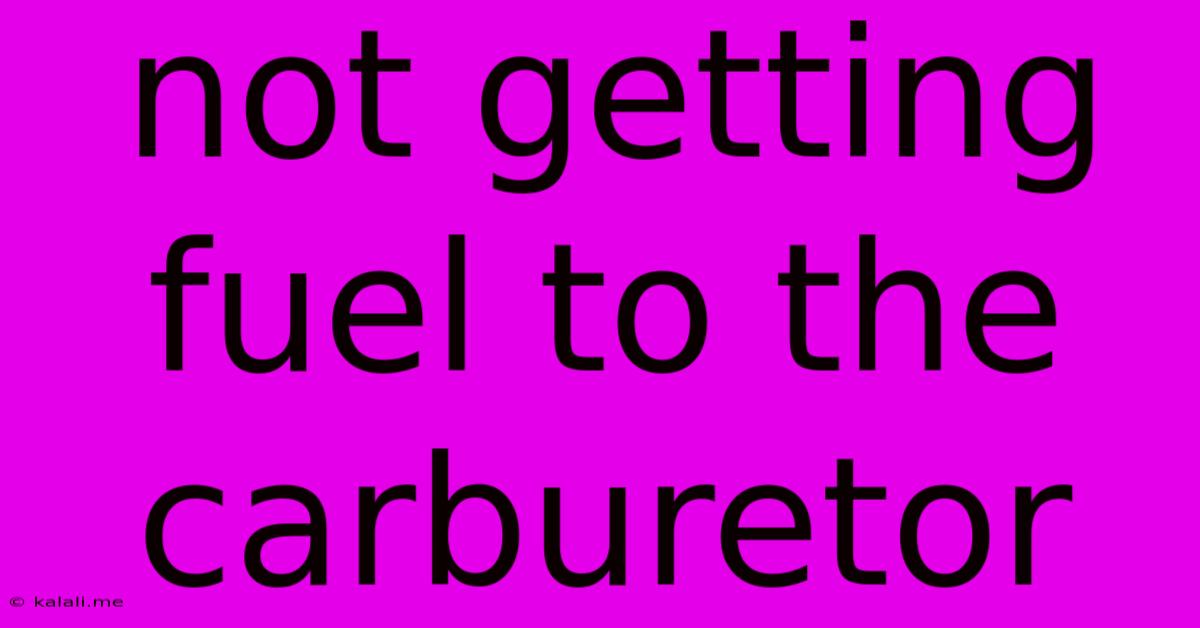Not Getting Fuel To The Carburetor
Kalali
Jun 03, 2025 · 3 min read

Table of Contents
No Fuel to the Carburetor: Troubleshooting Guide for Your Engine
Getting your engine to start and run smoothly relies on a consistent supply of fuel to the carburetor. If your engine is struggling or refusing to start, a lack of fuel reaching the carburetor is a common culprit. This comprehensive guide will walk you through the troubleshooting steps to diagnose and fix this issue. We'll cover everything from simple checks to more involved repairs, helping you get your engine back up and running.
Understanding the Fuel Delivery System
Before we dive into troubleshooting, let's briefly review how fuel gets to the carburetor. The process generally involves:
- Fuel Tank: The fuel originates here.
- Fuel Pump (Mechanical or Electric): This component draws fuel from the tank and pushes it towards the carburetor.
- Fuel Lines: These hoses carry the fuel from the pump to the carburetor.
- Fuel Filter: This component filters out debris and prevents contaminants from reaching the carburetor.
- Carburetor: This device mixes air and fuel to create a combustible mixture for the engine.
Troubleshooting Steps: Is Fuel Reaching Your Carburetor?
Let's systematically check each component to pinpoint the problem:
1. Check the Fuel Tank
- Fuel Level: The most obvious check! Ensure you have sufficient fuel in your tank. A low fuel level can prevent the pump from drawing fuel.
- Fuel Quality: Old or contaminated fuel can clog fuel lines and the carburetor. Consider draining and replacing the fuel if it's suspect. This is especially crucial if the fuel has been sitting unused for an extended period.
2. Inspect the Fuel Lines
- Leaks: Carefully examine the fuel lines for any cracks, leaks, or loose connections. Fuel leaks are dangerous and should be addressed immediately. Repair or replace any damaged lines.
- Clogs: Blockages in the fuel lines can severely restrict fuel flow. Try gently squeezing the fuel lines (with appropriate safety precautions!) to check for obstructions.
3. Examine the Fuel Pump
- Mechanical Pumps: These pumps are driven by the engine's camshaft. Check for proper operation – you might need to listen for the pump's characteristic whirring sound when the engine is cranked. If you hear nothing, the pump may be faulty.
- Electric Pumps: These pumps are activated by an electric signal. You might need a multimeter to test the pump's power supply and verify its functionality.
4. Check the Fuel Filter
- Clogged Filter: A dirty fuel filter restricts fuel flow. It's best to replace the fuel filter regularly as part of routine maintenance. Inspect your filter for blockages; a dirty or clogged filter will need to be replaced. This is a cheap and easy component to swap out.
5. Inspect the Carburetor
- Float Level: The float level within the carburetor regulates the fuel level. An incorrect float level can lead to insufficient fuel. This requires a more in-depth understanding of carburetor mechanics and may necessitate adjustment or repair.
- Clogged Jets: Small jets within the carburetor can become clogged, preventing fuel from flowing properly. Cleaning or replacing these jets often resolves the issue. This again requires carburetor specific knowledge.
Beyond the Basics: Other Considerations
- Fuel Pump Relay (Electric Pumps): If you're working with an electric fuel pump, a faulty relay can prevent the pump from receiving power.
- Ignition System: While this article focuses on fuel delivery, ignition issues can sometimes mimic fuel delivery problems. Ensure your spark plugs are firing correctly and your ignition system is functioning properly.
- Vacuum Leaks: Significant vacuum leaks can affect the engine’s ability to draw fuel, even if the fuel delivery system is otherwise fine.
Safety First!
Working with fuel is inherently dangerous. Always work in a well-ventilated area, and avoid sparks or open flames. Wear appropriate safety glasses and gloves. If you're not comfortable performing these repairs yourself, consult a qualified mechanic.
By systematically checking each component of the fuel delivery system, you'll greatly increase your chances of identifying the root cause of the "no fuel to carburetor" problem and getting your engine running smoothly again. Remember that preventative maintenance, including regular fuel filter changes, can significantly reduce the chances of encountering such issues.
Latest Posts
Latest Posts
-
Why Is Ouija Pronounced Like That
Jun 04, 2025
-
Basement Rigid Foam With Plastic Stud
Jun 04, 2025
-
Ac Compressor Turns Off But Fan Keeps Running
Jun 04, 2025
-
Can You Fit 11 Speed On Vbintage Road Bike
Jun 04, 2025
-
Mac Battery Degrading After Using External Monitor
Jun 04, 2025
Related Post
Thank you for visiting our website which covers about Not Getting Fuel To The Carburetor . We hope the information provided has been useful to you. Feel free to contact us if you have any questions or need further assistance. See you next time and don't miss to bookmark.